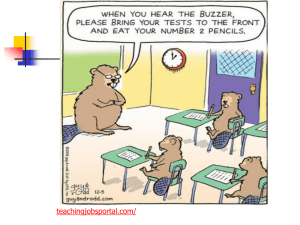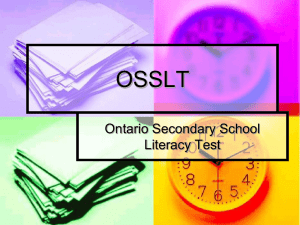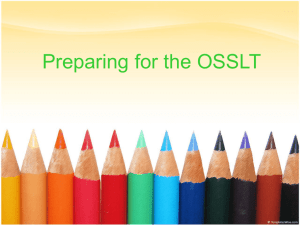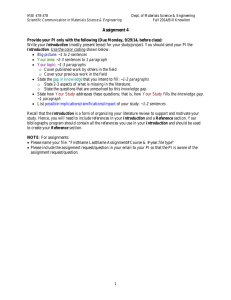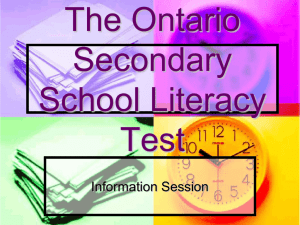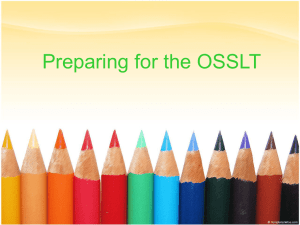Getting Ready for the OSSLT St. Joan of Arc Catholic Secondary School
advertisement
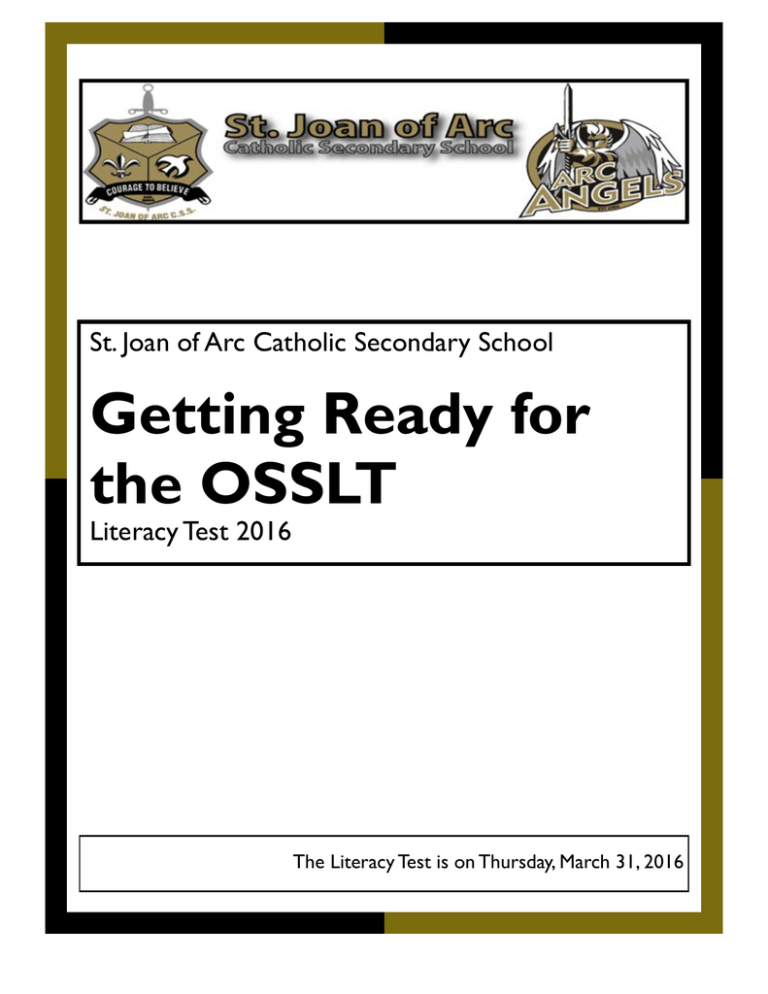
St. Joan of Arc Catholic Secondary School Getting Ready for the OSSLT Literacy Test 2016 The Literacy Test is on Thursday, March 31, 2016 Page 2 Getting Ready for the OSSLT Newsletter Contents What is the OSSLT? 2 What will the test include? 2 READING Types of Reading 3 Questions General Reading Tips 3-4 What is the OSSLT? The Ontario Secondary School Literacy Test (OSSLT) is a provincial test of literacy (reading and writing) skills that students have acquired by Grade 10. It is based on the literacy skills in the Ontario Curriculum across all subject areas up to the end of Grade 9. It also provides the Ontario education system with accurate, comparable data with which to assess current policies and curriculum. Students who do not pass the OSSLT can retake it a number of times. Students who have been eligible to write the OSSLT at least twice and have been unsuccessful at least once are eligible to fulfill the requirement through the Ontario Secondary School Literacy Course (OSSLC). Successful completion of the OSSLT or OSSLC is a graduation requirement. The test is written in one morning. For this school year, it will be held on March 26. Student must complete two test booklets. Each booklet is comprised of both reading and writing sections. Attendance for this test is mandatory! WRITING Basic Tips 5 Summary Writing 6 Series of Paragraphs 6 Writing a News Report 7 Short Writing Task 7 Additional Information 8 What will the test include? The test is designed to include questions that test both the reading and writing abilities of students. The test has short and long writing tasks, and multiple-choice questions that focus on three writing skills required in school and daily life. In reading, students are given examples of different types of reading selections: the information paragraph a news report dialogue real-life narrative graphic selection Students are then tested on their comprehension of what they have read. Students are required to demonstrate their writing skills through different formats: short writing tasks that require a response in six lines a series of paragraphs expressing an opinion a news report a summary There are also multiple‐choice questions testing writing skills. Specific Tasks: -5 reading passages -6 questions related to readings. Students are given 6 lines on which to answer in sentences -38 multiple choice questions related to the readings -8 questions based on grammar, spelling and reading and writing skills -2 short writing tasks -2 long writing tasks Getting Ready for the OSSLT Page 3 Reading on the OSSLT The OSSLT’s informational, narrative and graphic reading selections focus on three reading skills. To be successful on these readings you will have to: understanding explicitly (directly, literally) stated ideas and information understanding implicitly (indirectly, inferences) stated ideas and information make connections (interpretations) between information and ideas in a reading selection and personal knowledge and experience The reading selections include: information paragraph: presents ideas and information on a topic news report: presents information in the form of a news story dialogue: presents a conversation between two or more people real‐life narrative: an account of a significant time in an individual’s life graphic text: presents ideas and information with the help of graphic features, such as diagrams, photographs, drawings, sketches, patterns, timetables, maps, charts or tables Types of Reading Questions Types of questions: 1. Multiple‐choice Each reading text is followed by a number of multiple-choice questions. Students select the best or most correct answer from a list of four options. 2. Open‐response The information paragraph News report One or two open response questions. Students construct a response based on the reading selection. They should respond on the six lines provided. Reading Tips for the Test 1. Multiple Choice Read the entire question carefully. Choose the most correct answer. When you are asked to provide the "best meaning" of a word "as used in" the reading selection, refer back to the selection and choose the option that describes the word as used in that specific sentence. 2. Written Answers • Read each question carefully. • Since this is a reading test, many questions may be answered in a single word or phrase. • The space provided indicates the approximate length of the answer expected. • When a question requires you to give a reason or explain your answer, consider including the word "because" in your answer. Page 4 Getting Ready for the OSSLT Reading Tips for the Test Cont… Graphical Text Get an idea about the information in the reading section by scanning the text and the pictures before you attempt to answer the question. Attempt to block out sections of the graphical text when attempting to answer a question so you are not distracted by the rest of the images and words on the page. Read one question at a time. Find the information in the text that helps you answer the question. NOTE: You do not have to read the entire text before you begin to answer the questions. Informational Text Read the entire selection. Look at the graphic(s) to get additional information. Read one question at a time. Record your answer to the question. Find the information in the text that helps you answer the question. Go to the next question NOTE: Answer the questions based on your reading of the selection, not just your general knowledge of the topic. Literary Text Read the entire selection. Read one question at a time. Record your answer to the question. Go to the next question. Find the information in the text that helps you answer the question. NOTE: Answer the questions based on your reading of the selection, not just your general knowledge of the topic. Getting Ready for the OSSLT Page 5 Writing on the OSSLT The test has short and long writing tasks, and multiple‐choice questions that focus on three writing skills required in school and daily life: developing a main idea with sufficient supporting details organizing information and ideas in a coherent manner using conventions (spelling, grammar, punctuation) in a manner that does not distract from clear communication It is important that you follow the instructions and write in the required form. Read the assigned topic for each task carefully before you begin to write. Make sure your work is on‐topic and is in the required form. For the long and short writing tasks, use full and correctly written sentences. The four tasks are of different types that represent the range of writing required in school and daily life: a summary a series of paragraphs expressing an opinion a news report an information paragraph. Basic Tips for Students Writing the OSSLT All writing tasks must be written in complete sentences. The purpose and audience for your writing are indicated in the instructions preceding each writing task. You will notice that the audience is always an adult. This indicates that the language in your writing should be standard Canadian English and your ideas should be appropriate for an adult audience. Offensive or inappropriate language and ideas are not acceptable. There is to be absolutely NO webspeak, slang, jargon or abbreviations used on the literacy test. Each writing task is different. It is important to follow the instructions for each task. For example, the information paragraph must be written in a single paragraph. The series of paragraphs expressing an opinion asks for a minimum of three paragraphs. You may write more than three, but do not write fewer than three paragraphs. Some Basic things to keep in mind: Paragraph divisions must be clear. You may choose to use indentations or to leave an extra line between paragraphs. Be sure to write on the given topic in the form required by the task instructions. Writing that is off-topic or not in the specified form will receive a failing mark. Note: The series of paragraphs expressing an opinion is the only writing task that focuses on your opinion. To help your reader follow and understand your written work, organize your ideas clearly. Use transitions to link your ideas. The space provided for your written work indicates the approximate length of the writing required. Your writing skills cannot be assessed if you have not written enough. Make sure your handwriting is clear. Make changes to your writing as neatly and clearly as you can. Illegible handwriting cannot be marked. Use correct spelling, grammar and punctuation, so that your ideas are communicated clearly. Getting Ready for the OSSLT Page 6 Tips for Writing a Summary Before You Begin to Write While reading the original text, underline, circle or highlight important words. Find the main idea of the text and at least two important details that support it. Take into account the whole text. Plan your summary using the Rough Notes space provided beside the text you are summarizing. While You Write Write your summary in complete sentences in the lined space provided. You can reduce the number of words in several ways. These include leaving out nonessential information and unnecessary words, using one general word to substitute for several specific words and reducing the number of examples. Organize your ideas clearly to help your reader follow and understand your summary. Use transitions to link your ideas. Use correct spelling, grammar and punctuation, so that your ideas are clearly communicated. Make changes to your writing as neatly and as clearly as you can. Writing a Series of Paragraphs Expressing an Opinion Before you Begin to Write Determine your opinion on the topic question and consider your reasons for thinking this way. Form a plan. While you are Writing Write your series of paragraphs in complete sentences on the lined pages provided. In the introductory paragraph, clearly present your opinion; your opinion is your main idea. In the body paragraph(s), include supporting details (proof, facts, examples, etc.) that explain and give reasons for your opinion. In order to include enough supporting details, each body paragraph requires several sentences. In the concluding paragraph, summarize your opinion. Organize your ideas clearly to help your reader follow and understand your opinion. Use transitions to link your ideas. Use correct spelling, grammar and punctuation, so that your ideas are clearly communicated. Make changes to your writing as neatly and as clearly as you can. Getting Ready for the OSSLT Page 7 Tips for Writing a News Report Before you begin to write • Plan your news report. Think of some specific facts and information that answer the questions: Who? What? When? Where? Why? and How? Remember, you have to make up the facts and information. Jot down your ideas in the Rough Notes space. When you write • Write enough to ensure that your reader will feel fully informed about the event. • Include quotations from participants in the event or bystanders. • Organize your ideas clearly to help your reader follow and understand your news report. Use transitions to link your ideas. • Make changes to your writing as neatly and as clearly as you can. Tips for a Short Writing Task Before you begin to write Remember that you are limited by the number of lines available in the writing booklets. You will want to focus on using about five (5) sentences When you write Write your short writing task in complete sentences in the lined space provided. In your topic sentence, clearly state the main idea about the specific aspect of the topic you selected In the next two or three sentences, include information on 2-3 supporting points In your concluding sentence, summarize your main idea. Use correct spelling, grammar and punctuation, so that your ideas are clearly communicated. Make changes to your writing as neatly and as clearly as you can. St. Joan of Arc Catholic Secondary School Getting Ready for the OSSLT Literacy Test 2016 The Literacy Test is on Thursday, March 31, 2016
